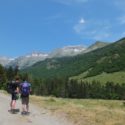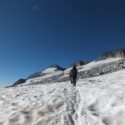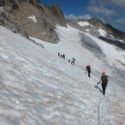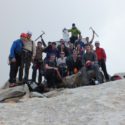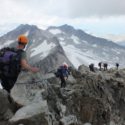Exercise Northern Alpinista consisted of a two week mountaineering expedition to the Benasque valley region within the Spanish Pyrenees. The expedition took place during July 2015 and was supported by 15 Officer Cadets (OCdts) from Leeds University Officers Training Corps and Regular and Reserve Forces instructors and staff. The location was chosen for its appeal as one of the most unspoilt natural environments within the mountains of Europe and because the prize set by the expedition leader would hopefully see the team summit the highest point within the Pyrenees.
The team set off from Leeds in order to undertake a two day sailing from Portsmouth. The journey by ferry was relaxed and helped with removing the stress of driving the enormous distances cross France and on into Spain. On arrival in Bilbao, Spain, the team moved by road with all stores and equipment to Benasque to set up base camp and start training. All the cadets were novice climbers and mountaineers so detailed training and instruction would be provided to prepare them fully for the alpine nature of the objective. Sitting at 3404m Pico Aneto was waiting patiently for the team’s attempt at its summit.
Firstly, the team would divide into groups of four and under the watchful eyes of their instructors, they planned and executed a 4 day acclimatisation trek around the Posets Massif. This involved utilising the Spanish mountain hut system along parts of the long distance route, GR11. The stunning natural beauty of the region was evident from the start.
It did not disappoint with its challenge as trekking was at altitude over long distances with soaring temperatures.
On arrival at each of the huts, they were found to be both welcoming and comfortable. Bed, breakfast and evening meal helped sustain the team. The food served was wholesome and nutritious allowing the team to quickly recover from the trials of the daily trek.
The idea at the conclusion of the Tour of Posets was to attempt to climb its summit (3371m). Unfortunately, this aspiration was curtailed by a rather menacing thunder storm at 4am on the day of the attempt.
The team then decided to return to the valley to continue with the training for the climb of Pico Aneto.
Technical rock climbing was then undertaken at a venue near Cerler. This was both challenging and enjoyable. The grades of climbs were diverse and allowed the team to train and get used to the exposure, whilst learning rope work and movement on steep rock.
Back at base camp, additional training centred on the fitting and use of crampons and the carriage and use of an ice axe along with additional rope work for glacier travel.
The summit of Pico Aneto was beckoning and so it was time to leave base camp once again for the high mountain environment and the attempt of the highest point in the Pyrenees.
The team arrived at the Refugio Renclusa (2140m), the final hut on the expedition and from where summit attempts of Aneto depart from. It was a busy hut but friendly and once again the food was appetising and in abundance. Breakfast at 5am marked the start of the day and by 6am the team were on route for the summit.
The night sky quickly gave way to bright sunshine and clear skies. The team moved on higher and higher across mountain scree and boulder fields to a col where the first glimpses of the mountain could be admired. High up across a glacier and snow field lay Pico Aneto. At the start of the glacier crampons and ice axe were both fitted and utilised as the teams roped up to safely cross the icy obstacle.
The summit was just out of sight but the slopes leading to its top were foreboding and presented a natural barrier to its final obstacle of rock, known as the “Bridge of Muhammad”. Named by Albert de Franqueville, who first climbed Aneto in July 1842, it refers to a Muslim legend that says the entrance to paradise is as narrow as the blade of a scimitar on which only the righteous pass. This was to prove a fitting analogy to the finale as the narrow knife edge arete we had to cross did not disappoint. A drop either side of the arête of several hundred feet focused the attention of the climbers.
At 1245pm on Tuesday 21 July 2015, the team, comprising of 15 OCdts and 4 instructors, proudly stood triumphant on the highest point of the Pyrenees, Pico Aneto. All safely returned to base camp elated. Finally, the post exercise administration started and all equipment and stores were checked and loaded before a few hours of R&R were enjoyed by the team. A celebratory barbeque followed by a few drinks in Benasque and last minute souvenir shopping concluded the expedition.
Special mentions go to OCdts Julia Summers and Tom Savage. Julia’s command of Spanish assisted with the smooth running of the expedition as language barriers were quickly overcome. Mr Savage, Tom, started out as a complete novice in all respects in relation to mountaineering and quickly assimilated the information and skills necessary to succeed. Well done. Safely back in the UK the team now all look forward to their next challenges, energised by their justifiably proud achievement.
Thank you to the instructors who assisted the team with expert instruction. Instruction delivered with professionalism, enthusiasm and a sharp sense of humour.
Captain Mark Bradbury AGC(RMP)
OIC Expedition Leeds UOTC

